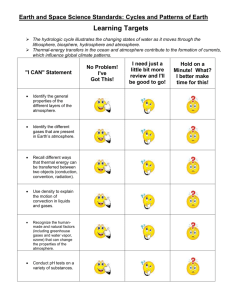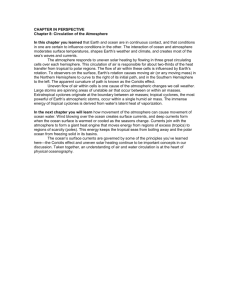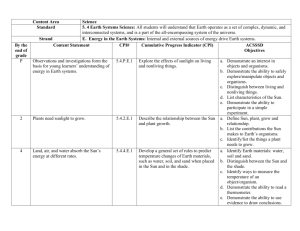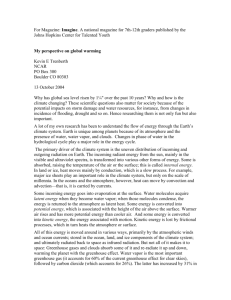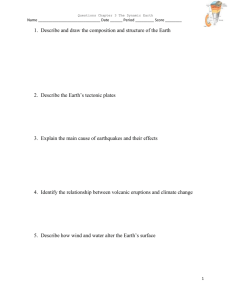The student will analyze and explain the movement of matter and
advertisement
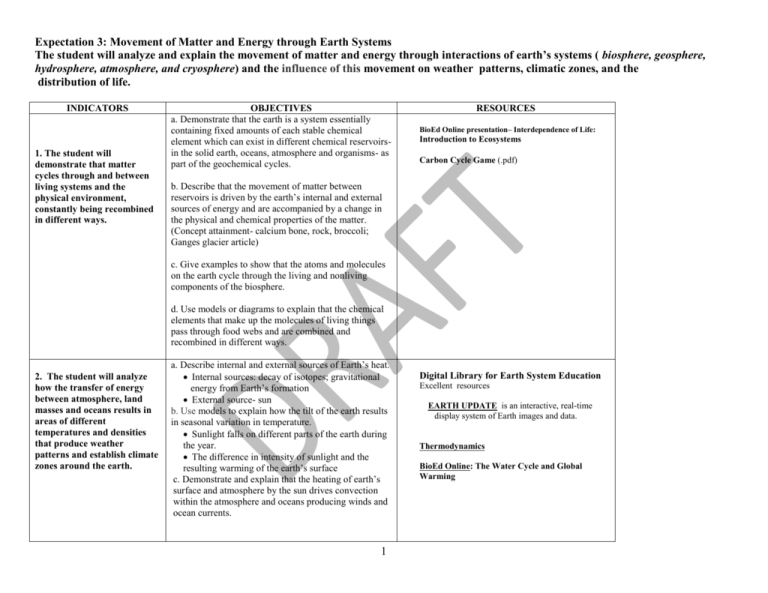
Expectation 3: Movement of Matter and Energy through Earth Systems The student will analyze and explain the movement of matter and energy through interactions of earth’s systems ( biosphere, geosphere, hydrosphere, atmosphere, and cryosphere) and the influence of this movement on weather patterns, climatic zones, and the distribution of life. INDICATORS 1. The student will demonstrate that matter cycles through and between living systems and the physical environment, constantly being recombined in different ways. OBJECTIVES a. Demonstrate that the earth is a system essentially containing fixed amounts of each stable chemical element which can exist in different chemical reservoirsin the solid earth, oceans, atmosphere and organisms- as part of the geochemical cycles. RESOURCES BioEd Online presentation– Interdependence of Life: Introduction to Ecosystems Carbon Cycle Game (.pdf) b. Describe that the movement of matter between reservoirs is driven by the earth’s internal and external sources of energy and are accompanied by a change in the physical and chemical properties of the matter. (Concept attainment- calcium bone, rock, broccoli; Ganges glacier article) c. Give examples to show that the atoms and molecules on the earth cycle through the living and nonliving components of the biosphere. d. Use models or diagrams to explain that the chemical elements that make up the molecules of living things pass through food webs and are combined and recombined in different ways. 2. The student will analyze how the transfer of energy between atmosphere, land masses and oceans results in areas of different temperatures and densities that produce weather patterns and establish climate zones around the earth. a. Describe internal and external sources of Earth’s heat. Internal sources: decay of isotopes; gravitational energy from Earth’s formation External source- sun b. Use models to explain how the tilt of the earth results in seasonal variation in temperature. Sunlight falls on different parts of the earth during the year. The difference in intensity of sunlight and the resulting warming of the earth’s surface c. Demonstrate and explain that the heating of earth’s surface and atmosphere by the sun drives convection within the atmosphere and oceans producing winds and ocean currents. 1 Digital Library for Earth System Education Excellent resources EARTH UPDATE is an interactive, real-time display system of Earth images and data. Thermodynamics BioEd Online: The Water Cycle and Global Warming Expectation 3: Movement of Matter and Energy through Earth Systems The student will analyze and explain the movement of matter and energy through interactions of earth’s systems ( biosphere, geosphere, hydrosphere, atmosphere, and cryosphere) and the influence of this movement on weather patterns, climatic zones, and the distribution of life. d. Explain that transfer of thermal energy between the atmosphere and the land or oceans produces temperature gradients in the atmosphere and the oceans. Regions of different temperatures rise or sink or mix, resulting in winds and ocean currents. Winds and ocean currents carry thermal energy from warm to cool areas. Winds and ocean currents are also affected by the earth’s rotation and land masses. e. Explain that transfer of thermal energy between the atmosphere and the land or oceans produces density gradients in the atmosphere and the oceans. Demonstrate and explain that in a fluid, regions that have different temperatures have different densities. Explain that the action of a gravitational force on regions of different densities causes them to rise or fall, creating currents that contribute to the transfer of energy. f. Demonstrate that global climate patterns are determined by dynamic and static energy transfer from the sun and the earth’s surface. Dynamic processes o Cloud cover o Ocean currents o Atmospheric circulation o Earth’s rotation Static conditions o Latitude, altitude o Position of mountain ranges, oceans, lakes g. Cite evidence that the earth’s climate has changed in the past, is currently changing, and is expected to change in the future. Evidence from plate tectonics Evidence from fossil finds Evidence of change in the composition of the atmosphere 2 Ups and Downs Forces that cause and affect tides. Model forces that cause and affect tides; analyze variations in tidal patterns and water levels in selected areas, and infer and discuss some conditions that may have influenced these variations, describe how tides affect our lives and explain the importance of monitoring tides. Motion in the Ocean What causes ocean currents and waves? Identify the primary causes for ocean currents and waves; explain how and why ocean currents vary with increasing latitude; explain the cause of the Coriolis effect, and how this effect influences ocean currents; calculate the magnitude of ocean currents, given data from drifter studies. Expectation 3: Movement of Matter and Energy through Earth Systems The student will analyze and explain the movement of matter and energy through interactions of earth’s systems ( biosphere, geosphere, hydrosphere, atmosphere, and cryosphere) and the influence of this movement on weather patterns, climatic zones, and the distribution of life. 3. The student will analyze and explain the movement of matter and energy through earth’s systems and the influence of this movement on the distribution of life a. Recognize and explain that the global distribution and abundance of organisms and populations in ecosystems are limited by the availability of matter and energy and the ability of the ecosystem to recycle materials (water, carbon, nitrogen, minerals). The ability of an ecosystem to recycle materials is affected by biotic and abiotic factors. Ocean habitats are defined by environmental factors such as salinity, temperature, oxygen, pH, light, nutrients, pressure, substrate, and circulation. o Due to the interactions of abiotic factors, ocean life is not evenly distributed spatially or temporally. Terrestrial distribution is defined primarily by temperature and precipitation. At times, environmental conditions are such that plants and marine organisms grow faster than decomposers can recycle them back into the environment, producing great coal beds and oil pools. b. Use scientific data to illustrate how critical factors and tolerance limits affect the distribution of organisms. c. Illustrate and explain that all of earth’s ecosystems, both terrestrial and marine, are linked through the movement of organisms and the flow of matter and energy. d. Cite evidence to show that changes in climate can produce very large changes in ecosystems. Eyes on the Estuary Monitoring Living Resources in Estuaries Retrieve and interpret data on the distribution of selected estuarine animals at various stages in the life history of these animals and relate these distributions to salinity conditions; compare the distribution of selected species in two or more estuaries, and to draw inferences about the ecology of these estuaries. Getting Physical with Estuaries Physical Factors in Estuary Environments Identify and quantify variations in selected physical factors in estuary environments. ; explain the relationships between water depth, salinity, temperature, and dissolved oxygen, and how variations in one of these factors can affect the others; given a series of observations on water depth, salinity, temperature, and dissolved oxygen in an estuary, make inferences about relationships and processes that explain these observations. Bottom Watching Describe at least three ways in which marine benthic habitats are important; describe at least three sources of stress that may adversely affect marine benthic habitats; describe factors that affect benthic distribution. A Step in Speciation: The Analysis of Field Observations – salamander speciation and distribution Using Microfossils in Petroleum Exploration Interpreting past environments based on distribution of microfossils Digital Library for Earth System Education Excellent resources 3

